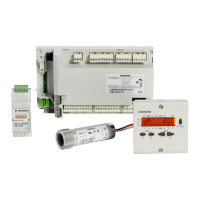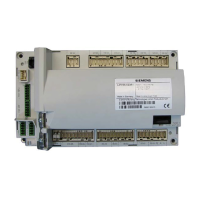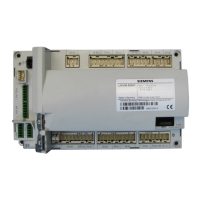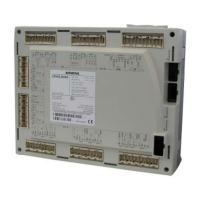32/213
Building Technologies Basic documentation LMV37.4... CC1P7546en
HVAC Products 6 Basic unit 01.12.2009
6.2.1 Loss of flame
In the event of loss of flame, the unit initiates safety shutdown, followed by a restart, if
required. A repetition counter can be used to select after how many losses of flame the
unit shall initiate lockout (refer to subsection Repetition counter).
Error
code
Diagnostic
code
Meaning for the LMV37.4... system
7 0 Loss of flame
No. Parameter
186
Software drop out delay time of flame signal (100 ms)
Index = = QRB... / QRC... (0 = inactive, >1)
Index 1 = ION / QRA... (0 = inactive, >3 - only 200 ms-steps)
240
Repetition limit loss of flame
1 = no repetition
2 = 1 repetition
280
Repetition limit loss of flame
1 = no repetition
2 = 1 repetition
Caution!
The response time of the flame detector leads to a prolongation of the second
safety time (TSA2)! This must be taken into consideration when designing the
burner!
6.2.2 Extraneous light
Extraneous light during standby (phase 12) leads to start prevention, followed by a re-
start. Extraneous light during the prepurge phase leads to immediate lockout. If extrane-
ous light occurs during the shutdown phase, the system switches to the safety phase.
One repetition is permitted. This means that if the error occurs again the next time the
system is shut down, the unit initiates lockout.
Error
code
Diagnostic
code
Meaning for the LMV37.4... system
4 0 Extraneous light during startup
1 Extraneous light during shutdown
2 Extraneous light during startup – start prevention
6.2.3 No flame at the end of safety time 1 (TSA1)
If no flame has been established at the end of the first safety time, the unit initiates lock-
out.
Error
code
Diagnostic
code
Meaning for the LMV37.4... system
2 1 No flame at the end of safety time 1 (TSA1)
2 No flame at the end of safety time 2 (TSA2)
6.2.4 Flame intensity
The flame’s intensity can be displayed.
It is standardized from 0 to 100%.
No. Parameter
954 Flame intensity

